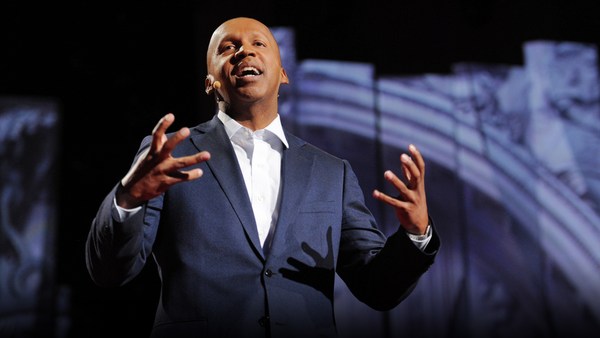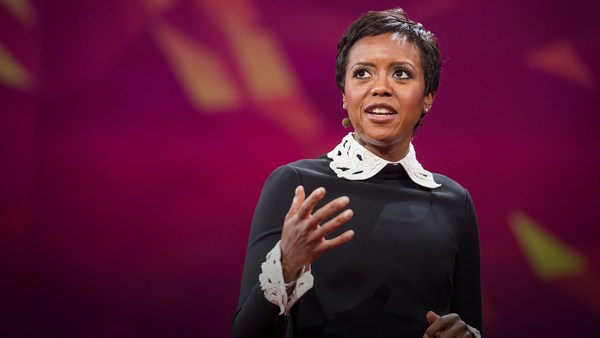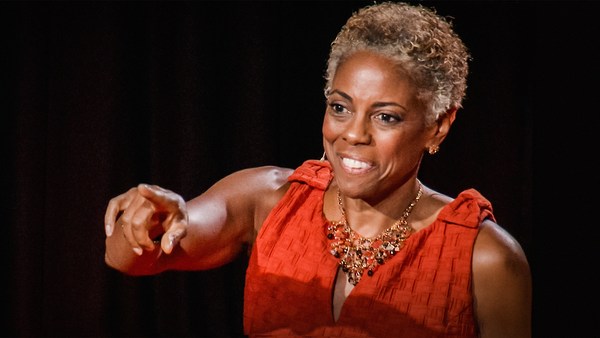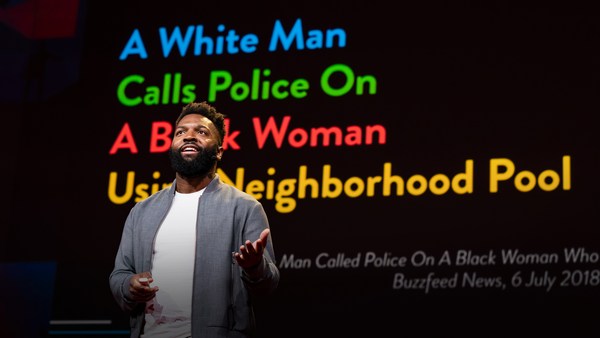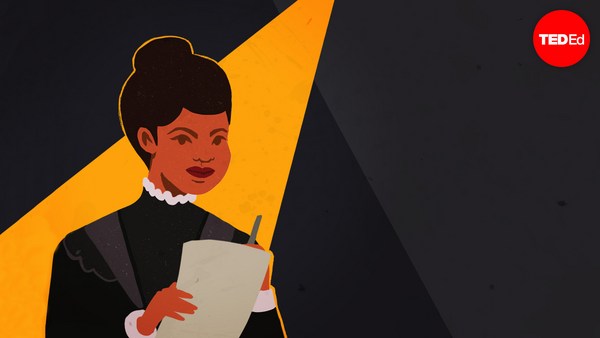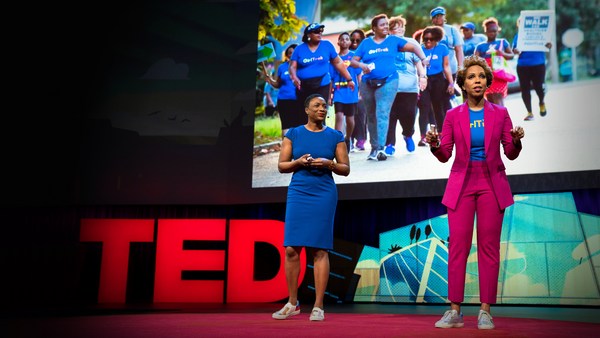I'd like to try something new. Those of you who are able, please stand up. OK, so I'm going to name some names. When you hear a name that you don't recognize, you can't tell me anything about them, I'd like you to take a seat and stay seated. The last person standing, we're going to see what they know. OK?
(Laughter)
All right. Eric Garner. Mike Brown. Tamir Rice. Freddie Gray.
So those of you who are still standing, I'd like you to turn around and take a look. I'd say half to most of the people are still standing. So let's continue.
Michelle Cusseaux. Tanisha Anderson. Aura Rosser. Meagan Hockaday.
So if we look around again, there are about four people still standing, and actually I'm not going to put you on the spot. I just say that to encourage transparency, so you can be seated.
(Laughter)
So those of you who recognized the first group of names know that these were African-Americans who have been killed by the police over the last two and a half years. What you may not know is that the other list is also African-Americans who have been killed within the last two years. Only one thing distinguishes the names that you know from the names that you don't know: gender.
So let me first let you know that there's nothing at all distinct about this audience that explains the pattern of recognition that we've just seen. I've done this exercise dozens of times around the country. I've done it to women's rights organizations. I've done it with civil rights groups. I've done it with professors. I've done it with students. I've done it with psychologists. I've done it with sociologists. I've done it even with progressive members of Congress. And everywhere, the awareness of the level of police violence that black women experience is exceedingly low.
Now, it is surprising, isn't it, that this would be the case. I mean, there are two issues involved here. There's police violence against African-Americans, and there's violence against women, two issues that have been talked about a lot lately. But when we think about who is implicated by these problems, when we think about who is victimized by these problems, the names of these black women never come to mind.
Now, communications experts tell us that when facts do not fit with the available frames, people have a difficult time incorporating new facts into their way of thinking about a problem. These women's names have slipped through our consciousness because there are no frames for us to see them, no frames for us to remember them, no frames for us to hold them. As a consequence, reporters don't lead with them, policymakers don't think about them, and politicians aren't encouraged or demanded that they speak to them.
Now, you might ask, why does a frame matter? I mean, after all, an issue that affects black people and an issue that affects women, wouldn't that necessarily include black people who are women and women who are black people? Well, the simple answer is that this is a trickle-down approach to social justice, and many times it just doesn't work. Without frames that allow us to see how social problems impact all the members of a targeted group, many will fall through the cracks of our movements, left to suffer in virtual isolation. But it doesn't have to be this way.
Many years ago, I began to use the term "intersectionality" to deal with the fact that many of our social justice problems like racism and sexism are often overlapping, creating multiple levels of social injustice.
Now, the experience that gave rise to intersectionality was my chance encounter with a woman named Emma DeGraffenreid. Emma DeGraffenreid was an African-American woman, a working wife and a mother. I actually read about Emma's story from the pages of a legal opinion written by a judge who had dismissed Emma's claim of race and gender discrimination against a local car manufacturing plant. Emma, like so many African-American women, sought better employment for her family and for others. She wanted to create a better life for her children and for her family. But she applied for a job, and she was not hired, and she believed that she was not hired because she was a black woman.
Now, the judge in question dismissed Emma's suit, and the argument for dismissing the suit was that the employer did hire African-Americans and the employer hired women. The real problem, though, that the judge was not willing to acknowledge was what Emma was actually trying to say, that the African-Americans that were hired, usually for industrial jobs, maintenance jobs, were all men. And the women that were hired, usually for secretarial or front-office work, were all white. Only if the court was able to see how these policies came together would he be able to see the double discrimination that Emma DeGraffenreid was facing. But the court refused to allow Emma to put two causes of action together to tell her story because he believed that, by allowing her to do that, she would be able to have preferential treatment. She would have an advantage by having two swings at the bat, when African-American men and white women only had one swing at the bat. But of course, neither African-American men or white women needed to combine a race and gender discrimination claim to tell the story of the discrimination they were experiencing. Why wasn't the real unfairness law's refusal to protect African-American women simply because their experiences weren't exactly the same as white women and African-American men? Rather than broadening the frame to include African-American women, the court simply tossed their case completely out of court.
Now, as a student of antidiscrimination law, as a feminist, as an antiracist, I was struck by this case. It felt to me like injustice squared. So first of all, black women weren't allowed to work at the plant. Second of all, the court doubled down on this exclusion by making it legally inconsequential. And to boot, there was no name for this problem. And we all know that, where there's no name for a problem, you can't see a problem, and when you can't see a problem, you pretty much can't solve it.
Many years later, I had come to recognize that the problem that Emma was facing was a framing problem. The frame that the court was using to see gender discrimination or to see race discrimination was partial, and it was distorting. For me, the challenge that I faced was trying to figure out whether there was an alternative narrative, a prism that would allow us to see Emma's dilemma, a prism that would allow us to rescue her from the cracks in the law, that would allow judges to see her story.
So it occurred to me, maybe a simple analogy to an intersection might allow judges to better see Emma's dilemma. So if we think about this intersection, the roads to the intersection would be the way that the workforce was structured by race and by gender. And then the traffic in those roads would be the hiring policies and the other practices that ran through those roads. Now, because Emma was both black and female, she was positioned precisely where those roads overlapped, experiencing the simultaneous impact of the company's gender and race traffic. The law -- the law is like that ambulance that shows up and is ready to treat Emma only if it can be shown that she was harmed on the race road or on the gender road but not where those roads intersected.
So what do you call being impacted by multiple forces and then abandoned to fend for yourself? Intersectionality seemed to do it for me.
I would go on to learn that African-American women, like other women of color, like other socially marginalized people all over the world, were facing all kinds of dilemmas and challenges as a consequence of intersectionality, intersections of race and gender, of heterosexism, transphobia, xenophobia, ableism, all of these social dynamics come together and create challenges that are sometimes quite unique. But in the same way that intersectionality raised our awareness to the way that black women live their lives, it also exposes the tragic circumstances under which African-American women die.
Police violence against black women is very real. The level of violence that black women face is such that it's not surprising that some of them do not survive their encounters with police. Black girls as young as seven, great grandmothers as old as 95 have been killed by the police. They've been killed in their living rooms, in their bedrooms. They've been killed in their cars. They've been killed on the street. They've been killed in front of their parents and they've been killed in front of their children. They have been shot to death. They have been stomped to death. They have been suffocated to death. They have been manhandled to death. They have been tasered to death. They've been killed when they've called for help. They've been killed when they were alone, and they've been killed when they were with others. They've been killed shopping while black, driving while black, having a mental disability while black, having a domestic disturbance while black. They've even been killed being homeless while black. They've been killed talking on the cell phone, laughing with friends, sitting in a car reported as stolen and making a U-turn in front of the White House with an infant strapped in the backseat of the car. Why don't we know these stories? Why is it that their lost lives don't generate the same amount of media attention and communal outcry as the lost lives of their fallen brothers? It's time for a change.
So what can we do? In 2014, the African-American Policy Forum began to demand that we "say her name" at rallies, at protests, at conferences, at meetings, anywhere and everywhere that state violence against black bodies is being discussed. But saying her name is not enough. We have to be willing to do more. We have to be willing to bear witness, to bear witness to the often painful realities that we would just rather not confront, the everyday violence and humiliation that many black women have had to face, black women across color, age, gender expression, sexuality and ability.
So we have the opportunity right now -- bearing in mind that some of the images that I'm about to share with you may be triggering for some -- to collectively bear witness to some of this violence. We're going to hear the voice of the phenomenal Abby Dobson. And as we sit with these women, some who have experienced violence and some who have not survived them, we have an opportunity to reverse what happened at the beginning of this talk, when we could not stand for these women because we did not know their names.
So at the end of this clip, there's going to be a roll call. Several black women's names will come up. I'd like those of you who are able to join us in saying these names as loud as you can, randomly, disorderly. Let's create a cacophony of sound to represent our intention to hold these women up, to sit with them, to bear witness to them, to bring them into the light.
(Singing) Abby Dobson: Say, say her name.
Say, say her name.
(Audience) Shelly!
(Audience) Kayla!
AD: Oh, say her name.
(Audience shouting names)
Say, say, say her name.
Say her name.
For all the names I'll never know,
say her name.
KC: Aiyanna Stanley Jones, Janisha Fonville, Kathryn Johnston, Kayla Moore, Michelle Cusseaux, Rekia Boyd, Shelly Frey, Tarika, Yvette Smith.
AD: Say her name.
KC: So I said at the beginning, if we can't see a problem, we can't fix a problem. Together, we've come together to bear witness to these women's lost lives. But the time now is to move from mourning and grief to action and transformation. This is something that we can do. It's up to us.
Thank you for joining us. Thank you.
(Applause)
